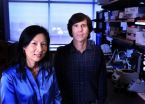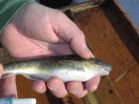(Press-News.org) Plants have for the first time been cloned as seeds. The research by aUC Davis plant scientists and their international collaborators, published Feb. 18 in the journal Science, is a major step towards making hybrid crop plants that can retain favorable traits from generation to generation.
Most successful crop varieties are hybrids, said Simon Chan, assistant professor of plant biology at UC Davis and an author of the paper. But when hybrids go through sexual reproduction, their traits, such as fruit size or frost resistance, get scrambled and may be lost.
"We're trying to make a hybrid that breeds true," Chan said, so that plants grown from the seed would be genetically identical to one parent.
Some plants, especially fruit trees, can be cloned from cuttings, but this approach is impractical for most crops. Other plants, especially weeds such as hawkweed and dandelions, can produce true seeds that are clones of themselves without sexual reproduction -- a still poorly understood process called apomixis.
The new discovery gets to the same result as apomixis, although by a different route, Chan said.
Normally, eggs and sperm are haploid -- they have half the number of chromosomes of the parent. The fertilized egg and the adult plant it grows into are diploid -- containing a full complement of chromosomes, half contributed by each parent.
Chan and his colleagues focused their work on the laboratory plant Arabidopsis, which has certain genetic mutations that allow it to produce diploid eggs without sexual recombination. These eggs have the same genes and number of chromosomes as their parents. But those eggs cannot be grown into adult plants without fertilization by sperm, which adds another parent's set of chromosomes.
Last year, Chan and UC Davis postdoctoral researcher Maruthachalam Ravi showed that they could breed haploid Arabidopsis plants that carried chromosomes from only one parent. They introduced a genetic change so that after the eggs were fertilized, the chromosomes from one of the parents were eliminated. Such haploid plants would reduce the time needed to breed new varieties.
In the new study, Chan's lab, with colleagues from India and France, crossed these Arabidopsis plants programmed to eliminate a parent's genes with either of two mutants that can produce diploid eggs.
The result? In about one-third of the seeds produced, the diploid eggs were successfully fertilized, then the chromosomes from one parent were eliminated, leaving a diploid seed that was a clone of one of its parents.
Ravi described the result as a step on the way towards artificial apomixis. The team hopes to produce crop plants, such as lettuce and tomato, that can fertilize themselves and produce clonal seeds. Applications for provisional patents on the work have been filed.
INFORMATION:
The other authors on the paper are: Mohan Marimuthu, Jayeshkumar Davda and Imran Siddiqi from the Centre for Cellular and Molecular Biology, Hyderabad, India; Sylvie Jolivet, Lucie Pereira, Laurence Cromer, Fabien Nogué and Raphaël Mercier, L'Institut National de la Recherche Agronomique, Versailles, France; and Lili Wang, UC Davis Department of Plant Biology.
The work was principally funded by the National Science Foundation.
END
Scientists have identified the gene that allows the Rubella virus to block cell death and reverse engineered a mutant gene that slows the virus's spread. Tom Hobman and a team of researchers at the University of Alberta's Faculty of Medicine and Dentistry believed that RNA viruses were able to spread by blocking the pathways in cells that lead to cell suicide, and isolated the responsible gene in Rubella, also known as German measles. They then created a mutant version of this gene that made the virus spread more slowly. These results are reported in PLoS Pathogens.
The ...
MADISON — Most people cross borders such as doorways or state lines without thinking much about it. Yet not all borders are places of limbo intended only for crossing. Some borders, like those between two materials that are brought together, are dynamic places where special things can happen.
For an electron moving from one material toward the other, this space is where it can join other electrons, which together can create current, magnetism or even light.
A multi-institutional team has made fundamental discoveries at the border regions, called interfaces, between ...
Glaucoma – a leading cause of vision loss and blindness worldwide – runs in families. A team of investigators from Vanderbilt University and the University of Florida has identified a new candidate gene for the most common form of the eye disorder, primary open angle glaucoma (POAG).
The findings, reported Feb. 17 in the open-access journal PLoS Genetics, offer novel insights into glaucoma pathology and could lead to targeted treatment strategies.
Elevated pressure inside the eye is a strong risk factor for POAG. Pressure increases because of increased resistance to the ...
Cases of ventilator-associated pneumonia — the most lethal and among the most common of all hospital-associated infections — dropped by more than 70 percent in Michigan hospitals where medical staff used a simple checklist designed by Johns Hopkins researchers. Such pneumonias kill an estimated 36,000 Americans each year.
The findings, published online in the journal Infection Control and Hospital Epidemiology, show how a relatively simple series of steps, coupled with an education program and a culture that promotes patient safety, can save tens of thousands of lives ...
PITTSBURGH, Feb. 17 – Researchers at the University of Pittsburgh have been awarded funding for two projects that will place brain-computer interfaces (BCI) in patients with spinal cord injuries to test if it is possible for them to control external devices, such as a computer cursor or a prosthetic limb, with their thoughts.
The projects build upon ongoing research conducted in epilepsy patients who had the interfaces temporarily placed on their brains and were able to move cursors and play computer games, as well as in monkeys that through interfaces guided a robotic ...
NEW YORK, Feb. 17, 2011 – A research group led by a New York University School of Medicine scientist discovered a genetic variant that allows a fish in the Hudson River to live in waters heavily polluted by PCBs. In a study published in the February 18, 2011, online issue of Science, they report that a population of Hudson River fish apparently evolved rapidly in response to the toxic chemicals, which were first introduced in 1929, and were banned fifty years later. PCBs, or polychlorinated biphenyls, were used in hundreds of industrial and commercial applications, especially ...
(Millbrook, N.Y. – Feb 17, 2011) Forest biomass could replace as much as one quarter of the liquid fossil fuel now being used for industrial and commercial heating in the Northeastern United States. That's according to a new report released today by the Cary Institute of Ecosystem Studies.
But the report also has sharp caveats: The potential for forest biomass varies widely within the region, and forest resources must be carefully managed to protect the other important services and goods they provide. Under the right circumstances, however, the report found that forest ...
Researchers at the University of California, San Diego School of Medicine have identified the motors that move non-infectious prion proteins (PrPC) – found within many mammalian cells – up and down long, neuronal transport pathways. Identifying normal movement mechanisms of PrPC may help researchers understand the spread of infectious prions within and between neurons to reach the brain, and aid in development of therapies to halt the transport.
Their study is published in the February 18 edition of the journal Cell.
The small prion protein is found in the cell membrane ...
For 30 years, two General Electric facilities released about 1.3 million pounds of polychlorinated biphenyls (PCBs) into New York's Hudson River, devastating and contaminating fish populations. Some 50 years later, one type of fish—the Atlantic tomcod—has not only survived but appears to be thriving in the hostile Hudson environment.
Researchers from Woods Hole Oceanographic Institution (WHOI) have joined colleagues from New York University (NYU) and NOAA to investigate this phenomenon and report that the tomcod living in the Hudson River have undergone a rapid evolutionary ...
New findings from researchers at New York Medical College suggest that when Social Security benefits are improved, people over the age of 65 benefit most, and may even live longer.
According to a new study published in the Journal of Public Health Policy, Americans over the age of 65 experienced steep declines in the rate of mortality in the periods that followed the founding of and subsequent improvements to Social Security. The authors urge that as Congress and the President discuss changes to Social Security they consider the benefit of reduced mortality and improved ...


